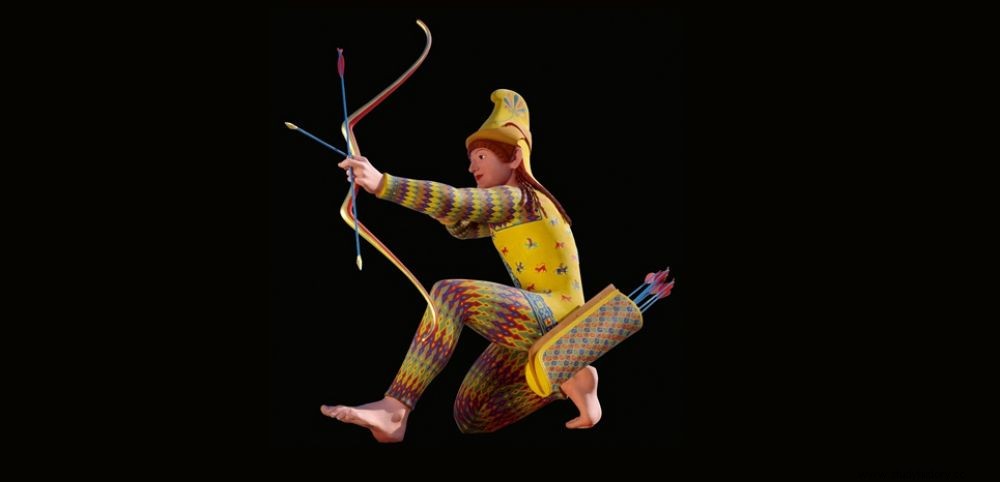 Trojan statue Paris, created by Vinzenz Brinkmann's team.
Trojan statue Paris, created by Vinzenz Brinkmann's team. ANTIQUE. Greek statues were not white. Not all of them, at least. This is a long-established fact, which brings together most scientists and historians, but which often remains unknown to the general public, to whom we more often present an idealized Greece radiating with immaculate whiteness. For more than thirty years, the German archaeologist Vinzenz Brinkmann has been scrutinizing, with increasingly sophisticated techniques, the traces left by the pigments on the marble statues, with the intention of restoring their luster of yesteryear. In an exhibition that has been traveling the world since 2003, Gods in Colour, Brinkmann offers reproductions of antique statues in real size and with the original colors - at least that's what he says. Because the colors of the statues presented in the video below are not unanimous among scientists.
X-rays, infrared and ultraviolet rays
Marble creations are among the most precious testimonies of Greco-Roman civilizations:although the Greeks adopted bronze sculpture as early as the 5th century BC, the statues that have survived the ages are above all their Roman replicas in marble. Marble has a definite conservation advantage:unlike bronze, it cannot be melted down to make weapons and armor in the event of a siege or shortage. And, as so often, it is new technologies that allow us to take a fresh look at centuries-old relics. However, as early as the Renaissance, when Greek and Roman statues returned to the center of attention, a few rare traces of paint were already visible to the naked eye - and some of them still are. P>
To recall the colors, some of which are around 2,500 years old, Vinzenz Brinkmann had to use a whole battery of instruments including high-intensity charged lamps, ultraviolet (UV) and infrared lamps. Indeed, if looking with the naked eye can reveal some traces of paint, it is also necessary to use ultraviolet light, which reveals the patterns by making certain organic compounds contained in the pigments fluoresce. To find the color, this time it is necessary to combine X-rays and infrared rays, whose wavelengths, on either side of the visible spectrum, are absorbed and reflected differently by each pigment, according to a behavior that scientists know extremely well. All you have to do is associate each spectrum with a pigment, each pigment with a color, and the riddle is solved. The statues were then molded, reproduced identically and painted by hand.
 The archer Paris displayed alongside other reconstructed sculptures by Vinzenz Brinkmann. Marsyas, CC-BY-SA-2.5
The archer Paris displayed alongside other reconstructed sculptures by Vinzenz Brinkmann. Marsyas, CC-BY-SA-2.5
"Compared to the rendering of colors, the reconstructions are bad". -Myriam Serck-Dewaide
If the Hellenistic gods made by Vinzenz Brinkmann do not arouse unanimity, it is above all because of the intensity of their colors. "Work from a Localization Perspective [patterns]is remarkable , says Myriam Serck-Dewaide, of the Royal Institute for Artistic Heritage in Brussels. But in terms of color rendering, the reconstructions are poor." According to her, the flat areas and garish colors of the replicas do not correspond to the great mastery of polychromy shown in the frescoes, vases and other works of art from the Hellenic world. With the current means, one cannot find the aesthetic quality of an object without an intact original model, as we were able to do in Egypt:"It is also very lively, but it is also very refined and very beautiful ”, continues Myriam Serck-Dewaide. In addition, the apparent color of a statue "is not only based on the nature of the pigments, it is also necessary to take into account the binders and the possible presence of an undercoat" , says Philippe Walter, of the Pierre and Marie Curie University (UPMC). "Other research has shown that the color was not uniform:by mixing several pigments, the Greeks could generate phenomena of shadow and light."
From a cultural and subjective point of view, some remain attached to the immaculate statues that we know and admire:accepting the idea that they were colored would imply rethinking the decoration of our most famous neoclassical buildings, from the White House at the Pantheon, but also the way in which our cathedrals, which once shone with a thousand lights, have been renovated. "I've always found sculpture boring, but at least the bronzes look like something, while the marble busts always look like a graveyard" writes Ernest Hemingway in Farewell to Arms . If he had been able to visit the Gods in Colour exhibition , the former American war correspondent might have changed his mind about the sculpture.
